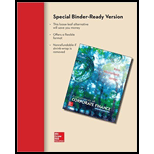
Concept explainers
To calculate: The points that Person X will be willing to pay the interest rate
Introduction:
The total sum of interest that is due for a particular time is the interest rate. The interest rate can be due for a period as a proportion of the sum borrowed or deposited and as the proportion of the sum lent.
The annual rate that is earned from the investment or charged for a borrowing is an annual percentage rate and it is also represented as APR. Thus, the APR is calculated by multiplying the rate of interest for a period with the number of months in a year. The effective annual rate is the rate of interest that is expressed as if it were compounded once in a year.
Answer to Problem 65QP
The maximum points that Person X would be willing to pay is 0.1601 or 1.601 points
Explanation of Solution
Given information:
Person X purchases a house and borrows $200,000 on a thirty year fixed rate mortgage. Person X has to pay on monthly basis to finance the purchase. The loan officer of Person X has offered him a mortgage with an annual percentage rate of 4%. The loan officer states Person X an alternative that he can buy down the rate of interest to 3.75% if he pays points up front on the loan. A point on the loan is 1% of the loan value.
Person X believes that he lives only for 8 years in the house before selling the house and purchase a new house. Thus, the Person X pays off the remaining balance of the real mortgage.
Note: The loan payment is for the first eight years and the remaining payment will be a balloon payment at the end. Thus there will be a 264-month payment.
Formula to calculate the monthly rate:
Compute the monthly rate with the original interest:
Hence, the monthly rate is 0.00333 or 0.333%
Formula to calculate the present value
Note: C represents the annual cash flow, r is the rate of exchange, and t denotes the period. The loan payments with the points are based on the original amount borrowed.
Compute the present value annuity:
Hence, the value for C is $954.83
Formula to calculate the balloon payment:
Note: C denotes the annual cash flow, r denotes the rate of exchange, and t denotes the period. The balloon payment is calculated using the formulae of the present value of annuity.
Compute the balloon payment using the formulae of the present value annuity:
Hence, the balloon payment is $167,460.95
Time line of the payments:

Compute the equation for amount borrowed:
Note: The actual amount that is received in front of the mortgage is the sum of borrowed amount and the points. Considering as X as the dollar amount of the points. The maximum number of points can be solved as it results in the cash flows that have a new rate of interest of 3.75%.
Formula to calculate the monthly rate:
Compute the monthly rate with the original interest:
Hence, the monthly rate is 0.00313 or 0.313%
Formula to calculate the present value annuity:
Note: To determine the maximum number of points that Person X is willing to pay, it is essential to set the annual percentage rate and the effective annual rate of loan with points and without points to be equal.
Compute the cash flows for maximum points using the formulae of present value annuity:
Hence, the maximum dollar amount is $3,202.16
Formula to calculate the maximum points:
Compute the maximum point:
Hence, the maximum points is 0.1601 or 1.601 points.
Want to see more full solutions like this?
Chapter 6 Solutions
Fundamentals of Corporate Finance (Special Edition for Rutgers Business School)
- QUESTION 2 You would like to purchase a home and are interested to find out how much you can borrow. When your lender calculates your debt to income ratio, he determines that your maximum monthly payment can be no more than $2,500. You would like to have a 30 yearfully amortizing loan and the interest rate offered on such a loan is currently 6%. Given these constraints, what is the largest loan you can obtain?arrow_forward41. Calculating Annuity Present Values [LO2] You want to borrow $95,000 from your local bank to buy a new sailboat. You can afford to make monthly payments of $1,850, but no more. Assuming monthly compounding, what is the highest rate you can afford on a 60-month APR loan?arrow_forwardTime Value of Money Calculations Q10 What if Aya and Sakura could only afford a monthly payment of $1800? What would be the maximum mortgage amount they could afford to borrow from the bank, if all the other conditions were the same? What is the total amount that would be paid to the lender over 25 years?arrow_forward
- 1. A consumer, who is initially a lender, remains a lender even after a decline in interest rates. Is this consumer better off or worse off after the change in interest rates? If the consumer becomes a borrower after the change is he better off or worse off? 2. What is the present value of $100 one year from now if the interest rate is 10%? What is the present value if the interest rate is 5%?arrow_forward4. Mortgage payments Mortgages, loans taken to purchase a property, involve regular payments at fixed intervals and are treated as reverse annuities. Mortgages are the reverse of annuities, because you get a lump-sum amount as a loan in the beginning, and then you make monthly payments to the lender. You've decided to buy a house that is valued at $1 million. You have $250,000 to use as a down payment on the house, and want to take out a mortgage for the remainder of the purchase price. Your bank has approved your $750,000 mortgage, and is offering a standard 30-year mortgage at a 10% fixed nominal interest rate (called the loan's annual percentage rate or APR). Under this loan proposal, your mortgage payment will be $6,581.57 per month. (Note: Round the final value of any interest rate used to four decimal places.) Your friends suggest that you take a 15-year mortgage, because a 30-year mortgage is too long and you will pay a lot of money on interest. If your bank approves a 15-year,…arrow_forward9. Suppose the interest rate is 3.8%. a. Having $600 today is equivalent to having what amount in one year? b. Having $600 in one year is equivalent to having what amount today? c. Which would you prefer, S600 today or $600 in one year? Does your answer depend on when you need the money? Why or why not? a. Having $600 today is equivalent to having what amount in one year? It is equivalent to $ (Round to the nearest cent.) b. Having $600 in one year is equivalent to having what amount today? It is equivalent to $ (Round to the nearest cent.) c. Which would you prefer, $600 today or $600 in one year? Does your answer depend on when you need the money? Why or why not? "Because money today is worth more than money in the future, $600 today is preferred to $600 in one year. This answer is correct even if you don't need the money today, because by investing the $600 you receive today at the current interest rate, you will have more than $600 in one year." Is the above statement true or…arrow_forward
- Suppose you take out a $117,000, 20-year mortgage loan to buy a condo. The interest rate on the loan is 5%. To keep things simple, we will assume you make payments on the loan annually at the end of each year. a. What is your annual payment on the loan? b. Construct a mortgage amortization. c. What fraction of your initial loan payment is interest? d. What fraction of your initial loan payment is amortization? e. What is the total of the loan amount paid off after 10 years (halfway through the life of the loan)? f. If the inflation rate is 3%, what is the real value of the first (year-end) payment? g. If the inflation rate is 3%, what is the real value of the last (year-end) payment? h. Now assume the inflation rate is 6% and the real interest rate on the loan is unchanged. What must be the new nominal interest rate? i-1. Recompute the amortization table. i-2. What is the real value of the first (year-end) payment in this high-inflation scenario? j. What is the real value of the last…arrow_forward(Q) You would like to purchase a home and are interested to find out how much you can borrow. When your lender calculates your debt to income ratio, he determines that your maximum monthly payment can be no more than $3, 200. You would like to have a 30 year fully amortizing loan and the interest rate offered on such a loan is currently 8.5%. Given these constraints, what is the largest loan you can obtain?arrow_forward. You borrow $2mn at an interest rate of 5% per year to purchase a real estate property for the cost of $2.5mn. The borrowing costs are due only at the end of the year. (a) Suppose you sell the property for $2.7mn at the end of the year. What is the return on your equity? (b) Suppose the price of the property declines to $2.3mn after one year. What is the return on your equity? (c) Suppose the interest rate at which you can borrow is 1%. How do your answers change?arrow_forward
- Suppose that you want to avoid paying interest and decide you'll only buy the furniture when you have the money to pay for it. An annuity is basically the opposite of a fixed-installment loan: you deposit a fixed amount each month and receive interest based on the total amount that's been saved. The future value formula is: A = [( The future value would be $ 12M 1+ 12 Y where M is the regular monthly payment, r is the annual interest rate in decimal form, and t is the term of the annuity in years. If you chose an annuity with a term of two years at 4.7% and a monthly payment of $100, the future value would be $2511.27. Recalculate the future value amount if you're willing to raise your monthly payment $20 per month. Round your answer to the nearest cent. 121 X 6arrow_forwardSuppose the interest rate is 3.6% b. Having $650 in one year is equivalent to having what amount today? c. Which would you prefer, $650 today or $650 in one year? Does your answer depend on when you need the money? Why or why not? **round to the nearest cent**arrow_forwardProblem. Suppose you want to purchase a home for $440,000 with a 30-year mortgage at 4.24% interest. Suppose also that you can put down 25%. Find (a) What are the monthly payments? (b) What is the total amount paid for principal and interest? (c) What is the amount saved if this home is financed for 15 years instead of for 30 years?arrow_forward
 PFIN (with PFIN Online, 1 term (6 months) Printed...FinanceISBN:9781337117005Author:Randall Billingsley, Lawrence J. Gitman, Michael D. JoehnkPublisher:Cengage Learning
PFIN (with PFIN Online, 1 term (6 months) Printed...FinanceISBN:9781337117005Author:Randall Billingsley, Lawrence J. Gitman, Michael D. JoehnkPublisher:Cengage Learning
